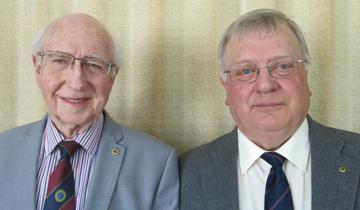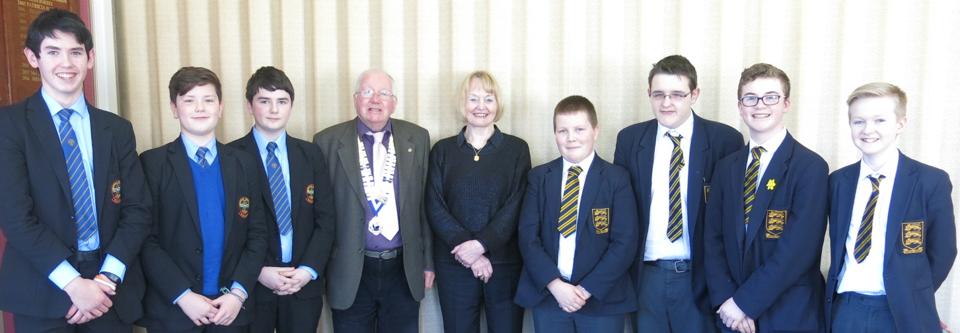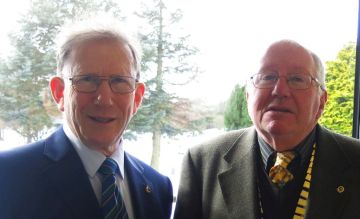Wednesday, 30 March 2016: Michael Cooney: Sacred Heart Church
![[L - R] Club Secretary, Gerry McGonigle with Club Member, Michael Cooney](http://www.omaghprobusclub.org.uk/wp-content/uploads/2016/08/p8sm_cooney.jpg)
Michael chose just 100 of his 1000+ photos of the church to illustrate his talk. Starting outside Michael showed a photo of two plaques on the smaller, St Patrick’s spire recording the placing of the corner stone and the dedication on completion of the church in 1899. The church was not consecrated until 1954 when the outstanding head rent was paid off. The church was designed by William Hague of Dublin (a protégé of Pugin) and cost some £46,000. A local benefactor, Edward Boyle, contributed £10,000 and other contributions came from Tyrone emigrés in the USA, Canada and GB. Photographs of the façade showed the detail in the stonework, images inspired by nature and the Gospel story. Carvings of oak leaves and shamrocks sit beside sculptures of the Saints and the Holy Family. Inside the beauty continues in the decorated capitals atop each of the columns, in the pulpit and altar rails, in the extensive wood carvings. The walls soar upwards to the beautiful wooden ceiling, honey-coloured when the sun streams through the stained glass windows. The magnificent East Window is particularly noteworthy. For visitors to Omagh the Sacred Heart Church stands today as a testament to both faith and beauty and is one of the treasures of our town.
Month: March 2016
Albert Allen: Mapping Ireland
Wednesday 23 March 2016: Albert Allen: Mapping Ireland

Having introduced himself as a land surveyor/cartographer with almost 50 yrs experience, Albert Allen talked about the mapping of Ireland between 1822 and 1836. This mapping was the first time a whole country was mapped at large scale. The man in charge was Lt.Col. Colby, an experienced surveyor who won the case for adopting the English standard yard as his base measure as opposed to the Irish perch of 7.0 yards related to the Irish mile. In the 19th century, surveyors used a system called triangulation. The method was to establish a baseline, and from this measure the angles in the network of triangles throughout Ireland. Some of these measurements were over 50 miles. A team of surveyors would shine a limelight which could be observed from other mountains. Angles were measured by purpose built theodolites. The baseline was a precisely measured line of almost 8 miles. It was re-measured in the 1960s using electronic distance measuring and found to be correct to less than 1”. Albert illustrated his talk with early maps of Omagh and was thanked for a fascinating lecture by Harman Scott
John Colhoun: Omagh “Accies”
Wednesday, 16 March 2016: John Colhoun: Omagh “Accies”
![[L - R] Derick Rainey, John Colhoun](http://www.omaghprobusclub.org.uk/wp-content/uploads/2016/08/p8sm_colhoun.jpg)
Through the use of archive photographs John brought to the screen several names and faces well known to many of those present. He recounted how the club had been formed by Dai Waterson Tom Hendly and Billy Beatty in 1952 and how the first matches were played on school pitches in Campsie. From 1955 to 1969 the Club was based in the Showgrounds before moving to its present location on the Derry Road. The site was purchased from local landowner, Robert Campbell, for £10,500, with money gifted to the club by the Mellon Foundation after whom the playing fields are named. The first of many club tours took place in 1956 when the team recorded an away win against “Racing Club de Paris. Tours to Canada, the Unites States and Australia followed with club growing all the while in confidence and stature. Promotion to the All-Ireland League in 1997 and success at Junior and Senior level saw the club’s collection of silverware grow. John rounded off an interesting talk with fond reminiscences about some of those who had served the club long and well over many years including “The Beat” and Dick Hinds, a former President of Probus. He was thanked by Derick Rainey who complimented John on his own dedication to the “Accies”, as Player, Captain, Coach, President and Chairman.
Inter-schools Debate
Wednesday, 9 March 2016: Inter-schools Debate

The motion that “This house believes that social media is destroying society” was proposed by Conall Rice [CBS] supported by Oisin McGuigan and Conor Lalsingh and opposed by Ryan Kane [OA] supported by Adam McFarland and Lewis Bratton with Harry Grace in reserve. All boys were third year pupils in their respective schools and spoke with a confidence and maturity which belied their age.
Conall opened for the proposition by arguing that the friendship which social media claims to promote cannot be achieved via a keyboard. Those who use Facebook often divulge enough personal information to make themselves targets for those who have posted fake profiles. Oisin developed the theme by graphic reference to users of social media hounded to suicide by internet predators. Conor observed that social media was making it increasingly difficult for some to distinguish between real and virtual relationships. Social media makes it easy for people to make out they are doing better in life than they actually are, causing others to become depressed.
Replying for the opposition Ryan began by identifying the huge commercial success of Social media and the billions of dollars of business generated by on-line trading. Far from destroying society the largest companies had donated billions to charity in their efforts to make society better. Adam pointed out that it was not the medium which was responsible for on-line bullying but the individuals who use it. He quoted examples of how people had been helped by social media in their search for missing persons and pets. Facebook was a way of communicating; Skype was a way of staying in touch and Google was a way accessing information on a global scale; Lewis developed the debate by describing how useful social media was in the classroom believed more kindness was exchanged in social media than hurt, and more happiness spread that harm.
The motion that was carried by 14 votes to 13, which accurately reflected the closeness of the debate. The teams were thanked for their participation by Probus President, Paul Gallagher and warmly congratulated by Probus members keen to say how much they had enjoyed the occasion.
Jim McBain: Keeping Churches Safe
Wednesday 2 March 2016: Jim McBain: Keeping Churches Safe

Club member, Jim McBain began by regretting that discussion about keeping churches safe for children and vulnerable adults was necessary, but news reports in recent times showed that it was now a concern for all church communities. Speaking as a member of the Methodist Church he described how each Methodist Church now had a “Designated Person” to ensure compliance with the law on safeguarding and child protection and the implementation of church policy. However all denominations were now committed to making churches safe with everyone – honest about the unpalatable possibility that congregations can house both Abusers and the Abused. Using training materials prepared by the Irish Methodist Youth and Children’s Department he examined the issues which this created and went on to demonstrate how volunteer youth workers were trained. This covered health and safety on church premises, interacting with children and the duty of care of adult leaders. He concluded by listing the questions which have to be asked to ensure that the church is a safe place for everyone. Jim was thanked for his talk by Probus President, Paul Gallagher, not least because he had stepped in at very short notice for a speaker who had been due to attend.